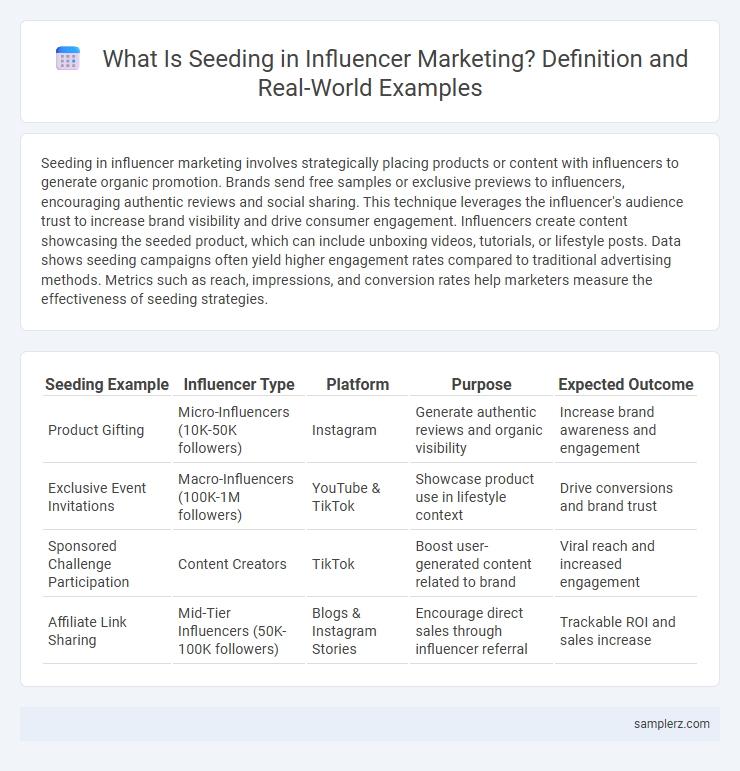Seeding in influencer marketing involves strategically placing products or content with influencers to generate organic promotion. Brands send free samples or exclusive previews to influencers, encouraging authentic reviews and social sharing. This technique leverages the influencer's audience trust to increase brand visibility and drive consumer engagement. Influencers create content showcasing the seeded product, which can include unboxing videos, tutorials, or lifestyle posts. Data shows seeding campaigns often yield higher engagement rates compared to traditional advertising methods. Metrics such as reach, impressions, and conversion rates help marketers measure the effectiveness of seeding strategies.
Table of Comparison
| Seeding Example | Influencer Type | Platform | Purpose | Expected Outcome |
|---|---|---|---|---|
| Product Gifting | Micro-Influencers (10K-50K followers) | Generate authentic reviews and organic visibility | Increase brand awareness and engagement | |
| Exclusive Event Invitations | Macro-Influencers (100K-1M followers) | YouTube & TikTok | Showcase product use in lifestyle context | Drive conversions and brand trust |
| Sponsored Challenge Participation | Content Creators | TikTok | Boost user-generated content related to brand | Viral reach and increased engagement |
| Affiliate Link Sharing | Mid-Tier Influencers (50K-100K followers) | Blogs & Instagram Stories | Encourage direct sales through influencer referral | Trackable ROI and sales increase |
What Is Influencer Seeding in Marketing?
Influencer seeding in marketing involves providing influencers with free products or exclusive content to generate authentic promotion and organic reach. This strategy leverages the influencer's trust and audience engagement, effectively boosting brand awareness and credibility. Brands track performance through engagement metrics like likes, shares, comments, and conversion rates to evaluate the success of seeding campaigns.
Key Benefits of Influencer Seeding Strategies
Influencer seeding strategies enable brands to organically amplify product awareness by leveraging trusted voices within niche communities, leading to higher engagement rates and authentic audience connections. By distributing samples or exclusive content to carefully selected influencers, companies benefit from increased brand credibility and enhanced word-of-mouth marketing. This approach drives measurable ROI through improved brand visibility and sustained consumer trust.
How Influencer Seeding Drives Authentic Brand Exposure
Influencer seeding drives authentic brand exposure by allowing brands to discreetly introduce products to trusted content creators who naturally integrate them into their daily routines and social media feeds. This organic placement fosters genuine user-generated content and word-of-mouth promotion, enhancing consumer trust and engagement. Metrics such as increased brand mentions, follower growth, and higher conversion rates demonstrate the effectiveness of influencer seeding strategies in expanding brand visibility.
Top Example: Beauty Brands Leveraging Influencer Seeding
Sephora excels in influencer seeding by gifting exclusive product bundles to top beauty influencers, generating authentic reviews and extensive social media buzz. Fenty Beauty leverages micro-influencers to seed limited-edition releases, boosting organic reach and engagement across Instagram and TikTok. Glossier's strategic seeding of new skincare lines to niche influencers fosters community-driven content that amplifies brand trust and customer loyalty.
Fashion Industry Case: Effective Seeding Campaigns
Seeding campaigns in the fashion industry leverage micro-influencers to authentically showcase new clothing lines, generating organic buzz and increasing brand visibility. For example, luxury brand Gucci partnered with emerging fashion bloggers by gifting exclusive pieces, resulting in highly engaging user-generated content and a measurable boost in social media followers. These targeted seeding efforts capitalize on niche audiences, driving higher engagement rates and conversion through genuine influencer endorsements.
Micro-Influencer Seeding Success Stories
Micro-influencer seeding campaigns have proven effective, with brands like Glossier leveraging niche beauty bloggers to generate authentic product buzz and drive substantial engagement. Studies show micro-influencers achieve 60% higher campaign ROI compared to traditional celebrity endorsements due to their targeted, loyal audiences. This strategy enhances brand trust and conversion rates by utilizing genuine content from relatable voices within specialized communities.
Seeding with Niche Influencers: Food and Beverage Examples
Seeding with niche influencers in the food and beverage industry involves providing specialized products like artisanal snacks or unique beverages to micro-influencers with dedicated foodie followings. These influencers generate authentic content showcasing unboxing, tasting, and recipe creation, amplifying brand visibility among targeted audiences. Brands such as Blue Bottle Coffee and RXBAR have successfully leveraged niche influencer seeding to enhance engagement and drive conversions within culinary communities.
Measuring ROI from Influencer Seeding Campaigns
Measuring ROI from influencer seeding campaigns involves tracking key performance indicators such as engagement rates, conversion metrics, and audience reach to assess the impact of product placements on sales. Utilizing unique promo codes and affiliate links enables precise attribution of revenue generated directly from influencer-driven traffic. Advanced analytics tools help marketers analyze sentiment, customer acquisition cost, and lifetime value to optimize future seeding strategies and maximize return on investment.
Dos and Don’ts of Influencer Seeding
Influencer seeding thrives on authentic product placement and personalized outreach, ensuring influencers genuinely connect with the brand to boost credibility and engagement. Avoid generic messaging or mass spamming, which can damage relationships and reduce campaign effectiveness. Prioritize long-term partnerships over one-off gimmicks to cultivate trust and maximize return on investment in influencer marketing strategies.
Future Trends: The Evolution of Influencer Seeding
Influencer seeding is evolving with the integration of AI-driven analytics to identify micro-influencers whose audience alignment predicts higher engagement rates. Brands increasingly leverage immersive technologies such as augmented reality for product placements within influencer content, enhancing authenticity and consumer interaction. Data from platforms like TikTok and Instagram reveal a surge in nano-influencer campaigns, signaling a shift towards hyper-personalized and scalable marketing strategies in 2024.

example of seeding in influencer Infographic
 samplerz.com
samplerz.com